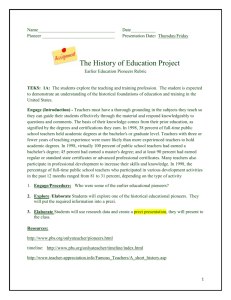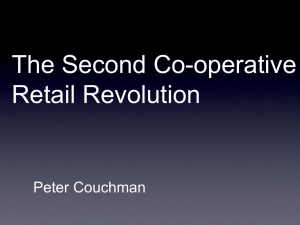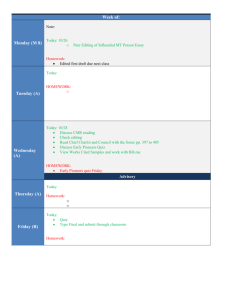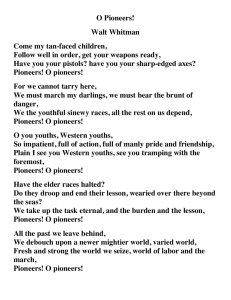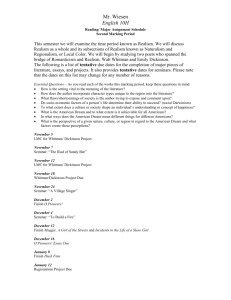File
advertisement
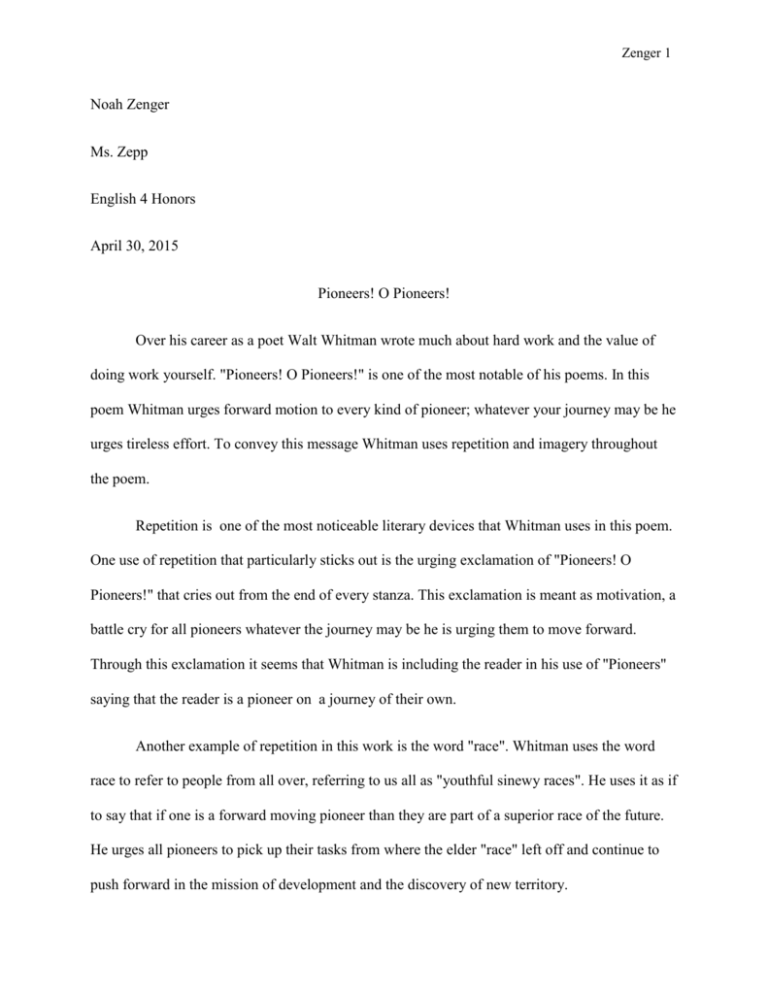
Zenger 1 Noah Zenger Ms. Zepp English 4 Honors April 30, 2015 Pioneers! O Pioneers! Over his career as a poet Walt Whitman wrote much about hard work and the value of doing work yourself. "Pioneers! O Pioneers!" is one of the most notable of his poems. In this poem Whitman urges forward motion to every kind of pioneer; whatever your journey may be he urges tireless effort. To convey this message Whitman uses repetition and imagery throughout the poem. Repetition is one of the most noticeable literary devices that Whitman uses in this poem. One use of repetition that particularly sticks out is the urging exclamation of "Pioneers! O Pioneers!" that cries out from the end of every stanza. This exclamation is meant as motivation, a battle cry for all pioneers whatever the journey may be he is urging them to move forward. Through this exclamation it seems that Whitman is including the reader in his use of "Pioneers" saying that the reader is a pioneer on a journey of their own. Another example of repetition in this work is the word "race". Whitman uses the word race to refer to people from all over, referring to us all as "youthful sinewy races". He uses it as if to say that if one is a forward moving pioneer than they are part of a superior race of the future. He urges all pioneers to pick up their tasks from where the elder "race" left off and continue to push forward in the mission of development and the discovery of new territory. Zenger 2 In "Pioneers! O Pioneers!" Whitman's uses of imagery are very vivid and really allow the reader to visualize this theme of forward motion. In the 6th stanza his uses of imagery are quite literally of the pioneers moving forward. "We detachments steady throwing, down the edges, through the passes, up the mountains steep, Conquering, holding, daring, venturing, as we go, the unknown ways, Pioneers! O pioneers!"(Whitman6) In this stanza, the reader can see the pioneers moving down cliffs, through passes, and up mountains. This imagery is not only meant literally but figuratively as well. Although Whitman is referring to the actual pioneers of the west, he is also referring to anyone on any kind of journey whether it is that of a exploration, scientific, personal, or spiritual nature. As long as one is moving forward in one sense or another, Whitman is urging them forward; warning them not to give up on their progress, not to walk away from their work. He encourages them to continue "pioneering" until the next generation is ready to pick up the task. Whitman's uses of imagery in the 7th stanza convey more than just moving forward but also the changes and progress that are made in the journeys of pioneers. "We primeval forests felling, We the rivers stemming, vexing we, and piercing deep the mines within; We the surface broad surveying, we the virgin soil upheaving, Pioneers! O pioneers!" (Whitman7) Zenger 3 Whitman's use of "primeval forests felling," show conveys not only the discovery of new territory but the changing of it; a progression of development in a new frontier. A similar idea is also supported by the line: "We the surface broad surveying,". The image of surveying a surface communicates not only discovery but planning for the future. As the surveyor builds upon the newly discovered soil, so the pioneer improves upon his older methods using what he learns from his latest discovery. Whitman makes a point by using the word "surface". This word's presence shows not only the planning of new developments, but also how much more there is left to be discovered. By using this one word Whitman shows the reality that as pioneers on our adventures we have only scratched the surface of what is left to discover. In the next line: "we the virgin soil upheaving," Whitman shows the piercing of the surface to develop the idea of the vastness of what is unknown to every pioneer. Of course this also reiterates the previously described concept of developing undiscovered territory. The upheaving of soil also conveys an idea of growth and new life. The upheaving of the soil could be to allow the planting of crops, which allows population growth. This image returns to the central idea of moving forward and advancing on the frontiers that all pioneers face in their personal and collective courses. This imagery continues in subtle ways through the lines, there is a short time of rest that is described in stanza 25: "Has the night descended? Was the road of late so toilsome? did we stop discouraged, nodding on our way? Zenger 4 Yet a passing hour I yield you, in your tracks to pause oblivious Pioneers! O pioneers!"(Whitman25) In this stanza the pioneers find the road ahead growing tough and get discouraged. Whitman allows them a time of rest near the end of their work. But the time of rest is short and Whitman concludes this ode with a call to arms; a final charge into the unknown, to make as much progress as they can before the youth are ready to pick up the great task from their elders. "Till with a sound of trumpet, Far, far off the day-break call-hark! how loud and clear I hear it wind; Swift! to the head of the army!-swift! spring to your places, Pioneers! O pioneers."(Whitman26) Whitman urges them on in this final call but this time the shouting of "Pioneers! O pioneers." is ended with a period to show that the end of this generation's struggle is near, and that it is almost time for the next generation to pick up their tools and continue into the unknown. Zenger 5 Works Cited Whitman, Walt. "Pioneers! O Pioneers!" Leaves of Grass. N.p.: n.p., 1900. N. pag. Print. Zenger 6

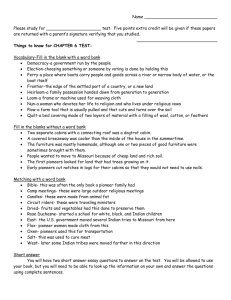
![Pioneers! O Pioneers! [excerpt] (1865)](http://s3.studylib.net/store/data/009625303_1-97477e83c178760551e424da5296a509-300x300.png)
